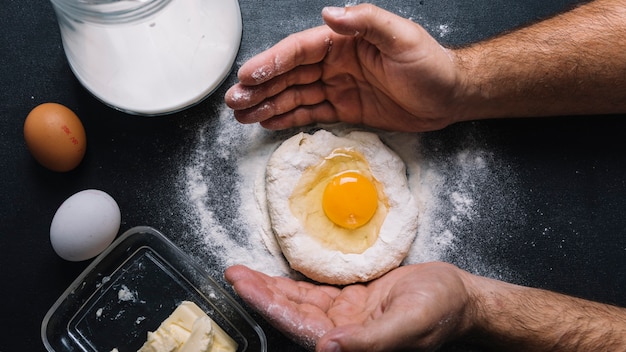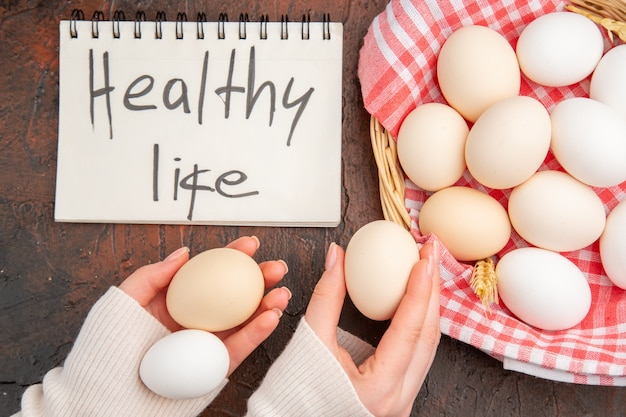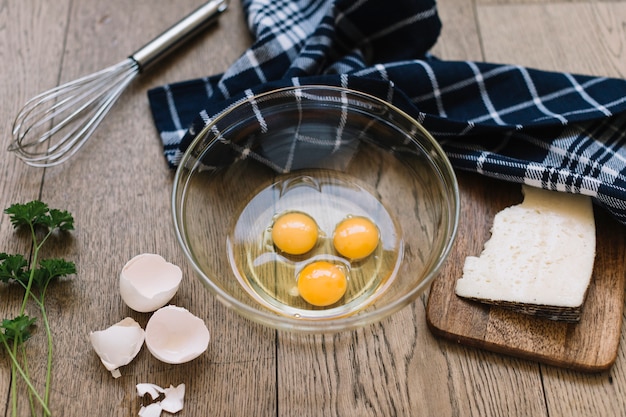Ah, the humble hard-boiled egg. A simple, versatile, and protein-packed snack or meal, it's a staple in many kitchens. But let's be honest, we've all had those moments of frustration: the yolk's too runny, the white's rubbery, or the dreaded green ring around the yolk. It's enough to make you swear off hard-boiled eggs altogether.
Over the years, I've experimented with different methods and timings, and I’ve finally mastered the art of the perfect hard-boiled egg. And believe me, it's a game-changer! This comprehensive guide will walk you through the science behind achieving that ideal texture, from choosing the right eggs to the perfect cooking time. By the end, you'll be confident in your ability to whip up flawlessly cooked hard-boiled eggs, whether you're making deviled eggs for a party or just a quick and healthy snack.
(Part 1) Unveiling the Science of perfect hard-boiled eggs

Before we dive into the specifics of cooking times and techniques, let's understand the science behind the process. The texture of a hard-boiled egg boils down to the coagulation of proteins in both the yolk and the white.
1.1 Coagulation: The Key to Texture
Think of protein molecules as long, tangled chains, initially loose and free-flowing. When heat is applied, these chains unravel and start to interlock, forming a more solid structure. This is the process of coagulation. The white coagulates at a lower temperature than the yolk, meaning it sets faster. This explains why the white solidifies first while the yolk remains runny in a soft-boiled egg.
1.2 Temperature's Role in Texture
The temperature and cooking time determine the extent of coagulation, ultimately influencing the texture. A short cooking time results in a runny yolk and a soft white, while overcooking leads to a rubbery white and a hard, crumbly yolk. The key to perfect hard-boiled eggs lies in finding the sweet spot where the yolk is firm yet creamy, and the white is set but not tough. But how do we achieve this elusive balance?
(Part 2) Choosing the Right Eggs: Setting the Stage for Success

The quality of your eggs plays a crucial role in the final outcome, so choosing the right ones is essential.
2.1 Freshness: A Foundation for Optimal Texture
Freshness is key for hard-boiled eggs! As eggs age, the air pocket inside expands, which can affect the coagulation process and lead to a less consistent texture. Aim for eggs that are within two weeks of their "best by" date. The fresher the egg, the more likely you are to achieve that smooth, even texture.
2.2 Size Matters: A Factor in Cooking Time
The size of the egg also influences the cooking time. Larger eggs will take longer to cook through than smaller ones. So, if you're using a mix of sizes, you'll need to adjust your cooking time accordingly to ensure even cooking.
Now that we've chosen our eggs, let's move on to the cooking process, where we can truly master the art of the perfect hard-boiled egg.
(Part 3) Mastering the Art of Cooking: Exploring Different Methods

There are several methods for cooking hard-boiled eggs, each with its own advantages and disadvantages. Here's a breakdown of the most popular methods:
3.1 The Classic Stovetop Method: Simple and Reliable
The stovetop method is the tried and true technique most of us are familiar with. It's simple, straightforward, and doesn't require any special equipment.
3.1.1 Instructions for Stovetop Method:
- Start by placing the eggs in a saucepan and covering them completely with cold water. Cold water allows the eggs to heat up gradually, reducing the risk of cracking.
- Add a tablespoon of salt to the water. Salt does more than just add flavour; it creates a more stable environment for the eggs, further minimizing the risk of cracking during cooking.
- Bring the water to a rolling boil over high heat.
- Once the water boils, immediately remove the pan from the heat. The key is to avoid overcooking the eggs, which can lead to a rubbery white and a crumbly yolk.
- Cover the pan tightly and let the eggs sit in the hot water for the desired amount of time. Refer to the chart below for recommended cooking times based on desired texture and egg size.
- After the allotted time, drain the hot water and immediately run cold water over the eggs for a few minutes. This stops the cooking process and prevents the yolk from turning green.
- Gently tap the eggs on a hard surface to crack the shell. Then, peel them under cold running water for easier removal.
3.2 The instant pot Method: Speed and Convenience
If you're looking for a faster and more convenient way to cook hard-boiled eggs, the Instant Pot is a game-changer. It delivers perfectly cooked eggs with minimal effort and mess.
3.2.1 Instructions for Instant Pot Method:
- Place the eggs in the Instant Pot trivet. The trivet ensures the eggs are evenly submerged in the water and cook consistently.
- Add one cup of water to the bottom of the Instant Pot. This creates the necessary steam for cooking the eggs.
- Close the lid and set the valve to seal. This creates the pressure necessary for quick and even cooking.
- Cook on manual pressure for 5 minutes for large eggs. Adjust the cooking time for smaller eggs based on the chart below.
- After the cooking time is up, perform a quick pressure release. This allows the steam to escape quickly and safely.
- Carefully remove the lid and transfer the eggs to a bowl of ice water to cool them down. This stops the cooking process and prevents the yolk from turning green.
- Once the eggs are cool, peel them as usual.
Both the stovetop and Instant Pot methods produce great results, so choose the one that best suits your needs and preferences. If you're looking for a simple, traditional method, the stovetop is a classic choice. If you're seeking speed and convenience, the Instant Pot is a great alternative.
(Part 4) Cracking the Code: How Long to Cook for Your Desired Texture
Now for the crucial part: determining the ideal cooking time to achieve your desired texture. Remember, the cooking time will vary slightly depending on the size of the eggs and your personal preference.
4.1 Cooking Time Chart for Hard-Boiled Eggs:
This chart provides a starting point for different textures. Feel free to adjust the cooking time according to your personal preference and the size of the eggs. You can always experiment to find your perfect cooking time.
| Texture | Small Eggs (1.5-1.75 oz) | Medium Eggs (1.75-2 oz) | Large Eggs (2-2.25 oz) | Extra Large Eggs (2.25-2.5 oz) |
|---|---|---|---|---|
| Soft Boiled ( runny yolk) | 3-4 minutes | 3-4.5 minutes | 4-5 minutes | 4.5-5.5 minutes |
| Medium Boiled (creamy yolk) | 5-6 minutes | 6-7 minutes | 7-8 minutes | 8-9 minutes |
| Hard Boiled (firm yolk) | 8-9 minutes | 9-10 minutes | 10-12 minutes | 11-13 minutes |
(Part 5) Tips and Tricks for Flawless Hard-Boiled Eggs
Here are some additional tips and tricks to help you achieve consistently perfect hard-boiled eggs:
5.1 Start with Cold Water: Preventing Cracking
Always begin by placing the eggs in cold water. This gradual heating process helps prevent the eggs from cracking during cooking.
5.2 Add Salt to the Water: For a Stable Environment
Adding a tablespoon of salt to the cooking water does more than just add flavour; it creates a more stable environment for the eggs, further reducing the risk of cracking.
5.3 Cool the Eggs Immediately After Cooking: Preventing the Green Ring
Immediately after cooking, transfer the eggs to a bowl of ice water. This stops the cooking process and prevents the yolk from turning green, a common problem caused by a reaction between hydrogen sulfide and iron in the yolk.
5.4 Peel Under Cold Water: For Easier Peeling
peeling hard-boiled eggs under cold running water helps to loosen the shell and makes the peeling process much easier.
(Part 6) The Green Ring Mystery: Understanding and Avoiding It
Let's address the infamous green ring around the yolk. It's a visual blight that can turn a perfectly good hard-boiled egg into an eyesore. This discolouration occurs due to a chemical reaction between hydrogen sulfide (released from the egg white during cooking) and iron in the yolk.
6.1 Prevention is Key: Methods to Avoid the Green Ring
While the green ring is more likely to occur with overcooked eggs, there are other things you can do to prevent it:
- Use fresh eggs: Older eggs tend to have higher sulfur levels, making them more susceptible to the green ring.
- Cook at a lower temperature: Cooking at a slightly lower temperature can help reduce the amount of hydrogen sulfide released during the process.
- Cool the eggs quickly: As mentioned before, immersing the eggs in ice water immediately after cooking is crucial to prevent the green ring from forming.
(Part 7) Beyond the Shell: Exploring the Versatile Uses of Hard-Boiled Eggs
Perfect hard-boiled eggs are incredibly versatile and delicious! They're a simple yet satisfying snack or meal, a nutritious addition to salads and sandwiches, and the star ingredient in countless recipes.
7.1 Snacks and Meals: A Quick and Healthy Option
Hard-boiled eggs are a great source of protein and can be enjoyed as a quick and healthy snack. They're also a perfect addition to salads, sandwiches, and breakfast bowls, adding a boost of flavour and nutrition.
7.2 Deviled Eggs: A Classic Party Appetizer
Who doesn't love deviled eggs? They're a classic party appetizer that's always a crowd-pleaser. They're a perfect way to showcase your hard-boiled egg skills and impress your guests.
7.3 egg salad: A Comforting and Versatile Spread
Hard-boiled eggs are the star ingredient in egg salad, a delicious and comforting sandwich filling or spread. It's perfect for a quick lunch or a simple dinner.
(Part 8) FAQs: Addressing Common Hard-Boiled Egg Questions
Here are some frequently asked questions about hard-boiled eggs to help you tackle any challenges you might encounter along the way.
8.1 What Happens if I Overcook Hard-Boiled Eggs?
Overcooking hard-boiled eggs can lead to a rubbery white and a hard, crumbly yolk, making them less enjoyable. It can also increase the chances of the yolk turning green.
8.2 How Can I Tell if an Egg is Cooked?
There are a few ways to determine if an egg is cooked. One simple method is to gently tap it on a hard surface. A cooked egg will produce a solid sound, while an uncooked egg will sound softer. You can also try spinning the egg on a flat surface. A cooked egg will spin smoothly, while an uncooked egg will wobble.
8.3 How Long Can I Store Hard-Boiled Eggs?
Hard-boiled eggs can be stored in the refrigerator for up to one week. To keep them moist and fresh, it's best to store them in a container filled with cold water.
8.4 Can I Freeze Hard-Boiled Eggs?
Freezing hard-boiled eggs is not recommended. The texture will change, and they may become rubbery, making them less appealing.
8.5 How Can I peel hard-boiled eggs Easily?
Peeling hard-boiled eggs can be a tricky task, but there are a few tips that can make it easier. You can try peeling them under cold running water, which helps to loosen the shell. Adding a teaspoon of baking soda to the cooking water can also make peeling easier. Finally, you can gently tap the egg on a hard surface to crack the shell, making it easier to peel.
Everyone is watching

Prime Rib Roast Cooking Time Chart: Per Pound Guide
Cooking TipsPrime rib roast. Just the name conjures images of lavish dinners, crackling fires, and hearty laughter. It’s ...

How Long to Bake Potatoes in the Oven (Perfect Every Time)
Cooking TipsBaked potatoes are a staple in my kitchen. They're incredibly versatile, delicious, and surprisingly easy to m...

Perfect Rice Every Time: The Ultimate Guide to Cooking Rice
Cooking TipsAs a self-proclaimed foodie, I've always been a bit obsessed with rice. It's the foundation of countless cuisi...

The Ultimate Guide to Cooking Asparagus: Tips, Techniques, and Recipes
Cooking TipsAsparagus. The mere mention of this spring delicacy conjures up images of vibrant green spears, crisp and burs...

Ultimate Guide to Cooking the Perfect Thanksgiving Turkey
Cooking TipsThanksgiving. Just the word conjures up images of overflowing tables laden with delicious food, the scent of r...
